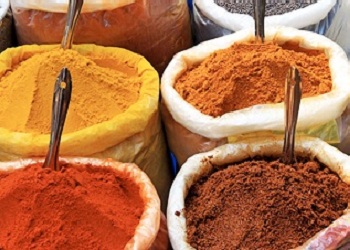After some encouraging feedback from the previous blog, here I will try to delve a bit deeper into a further three spices used extensively in Indian cookery: chilli, mustard and black pepper.
Chilli
There are 400 different varieties of chillies grown across the world and India produces 127 varieties out of them. Chillies are the life of Indian dishes. They are added in ground form, whole fresh form, and whole dried form. The plant is native to the Americas, and the Portuguese brought them to India in the 16th Century. Black Pepper was used as the main source of heat for dishes before this. They grow all over India, varying in size, shape and potency. Their heat level is measured on a Scoville Scale, and chillies get their heat through capsaicin, found in the white membrane holding the seeds together. The seeds absorb much of the capsaicin and so should be removed to reduce the heat of the chilli. Capsaicin is insoluble in water and so the burning sensation cannot be expelled unless fat or dairy is consumed like milk, yogurt and raita.
Appearance / Taste / Aroma / Uses:
Chillies can vary in colour from green to red. They grow green and as they ripen they turn different shades of the spectrum until they finally turn red. They can be eaten either unripe or ripe. Unripe chillies will spoil if they are dried, and so all dried chillies are red. Hence dried chilli powder is also red.
Many chillies can bring on an appetite not only with pungency but also with fruity, floral, smoky, nutty, tobacco, or liquorice flavours. As a general rule, larger chillies tend to be less potent than smaller chillies. Indians prefer to use the birdseye chillies, but every region in India has its own chilli variety. The Naga Chilli is said to be one of the hottest in the world.
Ayurvedic Healing Properties:
Chillies are an excellent source of vitamin A, which promotes healthy growth of skin and cells. It is also a great source of Vitamin C, which is good for curing colds and coughs. Chillies are known to stimulate the release of endorphins, which are a natural painkiller. They are also linked to help the prevention of cancer.
Mustard Seed
The seeds of the mustard greens are small and round, and they come in 3 varieties: white, yellow and brown/black. Black and brown mustard seeds are the most common in cooked Indian dishes. The yellow variety is used in pickles.
Appearance / Taste / Aroma / Uses:
A whole mustard seed has no aroma. When ground it can be pungent and strong earthy aromas are released. The black seeds have a strong hot flavour; the brown seeds are slightly bitter and also have a longer-lasting pungency.
Mustard seeds form part of the “Panch Phoran” spice mix, which is native to Eastern India. They use mustard extensively in their cooking. They use mustard oil, mustard seed, ground mustard powder and a paste called Kasundi in their dishes. Gujarat and Punjab also use mustard oil in the cooking.
Whole seeds are usually dry roasted or heated in hot oil/ghee to produce a “Tadka”. This brings out an attractive nutty flavour. The oil is heated to almost smoking point, where it loses much of its pungency.
Ayurvedic Healing Properties:
When made into a paste mustard seeds are said to relieve sore, tired and aching feet. It is also known to relieve muscular pain and so is often used in massage oils.
Black Pepper
The history of the spice trade is essentially about the quest for pepper that came from India’s Malabar Coast. Pepper is the “King of Spices” and often referred to as "black gold". It was used as commodity money many years ago.
Appearance / Taste / Aroma / Uses:
The pepper plant is a woody vine that grows up to 4 metres tall on supporting trees and poles. The pepper pods hang down from the plant in bunches. They turn green in colour. If they are left on the plant they will turn red. Black pepper comes from the green unripe peppercorns. They are picked and boiled briefly in hot water. They are then sundried, when the skin darkens and wrinkles. Large dark brown to black peppercorns command the highest price. If the husks are removed they create white pepper.
They can be freeze dried as a green peppercorn to produce the colourful dried pepper found in pepper mills, as can the ripened red peppercorns. They are often found pickled in brine or vinegar. Pink peppercorns are a fruit from a different plant and have a different flavour.
Black pepper has a strong flavour that deteriorates quickly when ground, if not stored away from sunlight in an airtight container. It is used as a spice in Indian cooking and not as a condiment as in most other cuisines. In masalas and blends it is added towards the beginning when frying other whole spices. Black pepper has a strong aroma and pungency and is an important ingredient in “Garam Masala”.
Ayurvedic Healing Properties:
Black pepper has good antibacterial qualities that help cure a wide range of diseases. It is good for colds and coughs and for those suffering from indigestion.
Spice: A Way of Life II
Jay Ghosh of Indian restaurant Potli gives us the second installment of his blog on spices... giving you heaps of info on background, tastes, uses and why they might be good for you.

Published Jul 25, 2012
